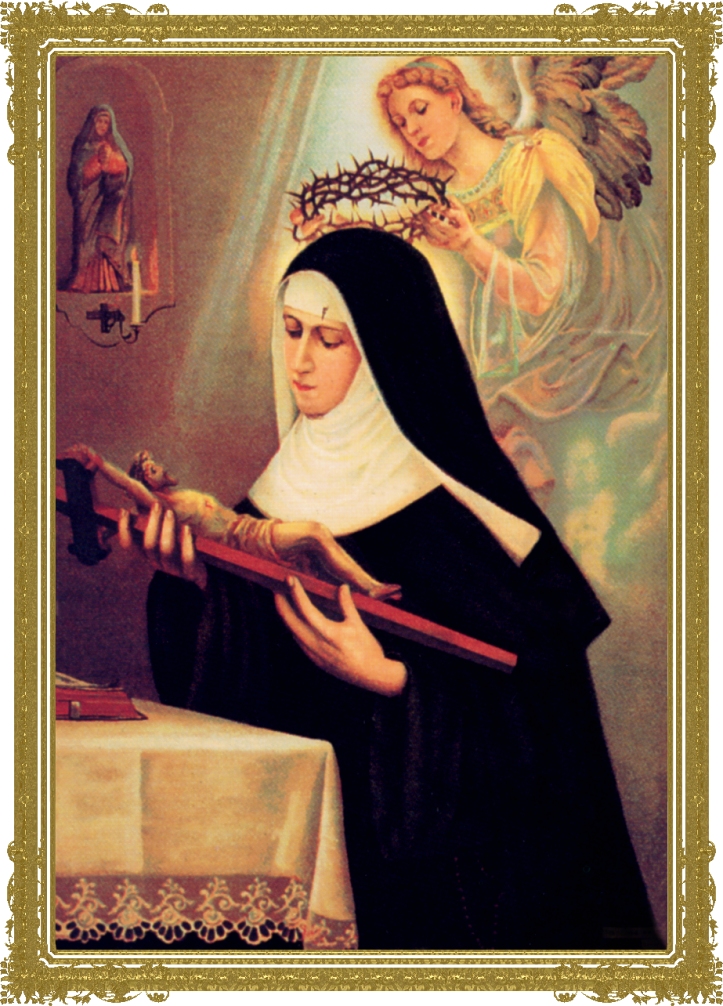

CANONIZATION
THE UNIVERSAL and uninterrupted devotion of the faithful to St. Rita and the very many wonderful prodigies that God wrought through her intercession enkindled in the loving hearts of thousands and thousands of the clients of the humble Augustinian nun the ardent desire of seeing her elevated to that highest honor with which Holy Mother Church recompenses the heroic virtues of her pious and devout children. This ardent desire began to manifest itself shortly after her Beatification. However, generation after generation of the devout clients of St. Rita went to their reward without seeing the realization of their wishes. But at length the happy time came, after a lapse of two centuries of years and more. The year 1900 will long be remembered by the friars and nuns of the Order of St. Augustine, as well as by the loving and devout clients of St. Rita. In this year, on the 24th of May, Pope Leo XIII, of happy memory, decreed that Blessed Rita, O.S.A. of Cascia should be honored as a Saint, in public and in private; that her name be inscribed in the catalogue of the Saints, and that her memory should be held in perpetual veneration on the 22nd day of May each year by the Universal Church.
We will mention some of the details that anteceded the Canonization of St. Rita. In the year 1737, a few years more than a century after her Beatification, the Apostolic Process of the virtues and particularly of the miracles of St. Rita was begun. This Process was conducted by the diocesan tribunals of Spoleto and Nursia. For different reasons, some particular, some general, the Process was delayed for more than a century. On the 9th of September, in the year 1851, letters were sent from Rome to the bishop of Nursia to reopen and complete the Process. The procedure lasted four years. In 1855 the Process was sent to Rome, approved the following year by the Sacred Congregation of Rites, and confirmed by a decree of Pope Pius IX, the 29th of May, in the year 1856. On June 8th, in the year of Our Lord 1896, the Sacred Congregation approved the Process made in the year 1626 of the sanctity, virtues and worship to the Saint, thereby giving it the value of an Apostolic Process. On April 6th, in the year 1897, the same Congregation approved the Process of the virtues of St. Rita and declared that steps could be taken at once to examine the miracles attributed to the Saint. After a long and careful examination, as the Church is accustomed to do in such cases, Pope Leo XIII, by a decree dated Palm Sunday, April 8th, in the year 1900, approved, among the many, the miracles attributed to St. Rita and declared that they could, with all security, proceed to the solemn Canonization of the Saint. The following were the three miracles that were approved, as we may learn from the Decree of St. Rita's Canonization.
"The first miracle consists of that pleasing scent emanating from the remains of the Saint's body, the existence of which is confirmed by many reliable witnesses and trustworthy tradition, so that to doubt concerning this fact would be absurd; moreover no natural cause can be given for the existence of this odor, as we see from the physical research which has been made by men most skilled in such things. Furthermore this odor diffuses itself in a manner above the usual laws of nature. Hence we should be persuaded that this fragrance has its origin through Divine intervention.
"The other miracle happened to Elizabeth Bergamini, a young girl in danger of losing her sight from smallpox. Her parents, assured by the physicians that the child's condition was so serious that medical aid could be of no avail, decided to send her to the Augustinian Convent at Cascia, beseeching St. Rita fervently to deliver their daughter from approaching blindness. Arriving at the convent, the child was clothed with a votive dress in honor of St. Rita. After four months Elizabeth cried out one day that she could see. Together with the nuns she immediately began to give thanks to God, who had wrought such a miracle through St. Rita.
"The third miracle happened to Cosimo Pelligrini, suffering from chronic catarrhal gastroenteritis and hemorrhoidal affection so serious that there was no hope of recovery. Returning one day from church he became so weak from a new attack of his excruciating malady that he was near death. Doctors, being summoned, ordered him to receive the last Sacraments, receiving which he lay in the bed with every appearance of approaching death, when suddenly he seemed to see St. Rita in the attitude of greeting him. Thereupon his former strength and appetite returned to him, and within a very short time he was able to do the work of a young man, although he was advanced in years, being a septuagenarian."
In consideration of the approval of the virtues and miracles of the humble Augustinian nun, Pope Leo XIII issued the Decree of Canonization, and appointed Ascension Day, May 24th, 1900, for the happy event. On this memorable day, two blessed servants of God were canonized: Blessed John Baptist de La Salle, Founder of the Brothers of the Christian Schools, and our own Blessed Rita of Cascia, known throughout the entire Catholic world as the Saint of the Impossible.
On that occasion there was present a large multitude of people. Pilgrims had come from Ireland, England, France, Germany, Spain, America and from every province in Italy to witness the rarest and most solemn of ceremonies of Holy Church. In preparation for the canonization, more than 1500 persons were employed under the direction of Constantine Sneider, who had charge of the decorations of the Vatican. It was on this occasion that electric light was used for the first time in St. Peter's Church. Nearly 11,000,000 feet of wire supplied the current for 12,000 lamps and 400 chandeliers.
At an early hour of the morning of May 24th, 1900, there was assembled in the plaza of St. Peter an immense multitude of people of every nationality and language, indicating that the entire world was represented. The front of St. Peter's Church stood forth in all its majestic beauty, enhanced by the splendor of its gorgeous and magnificent decorations.
In the meantime, there were assembled in the Vatican Palace awaiting the beginning of the ceremonies: the Sacred College of Cardinals; Patriarchs; Archbishops and Bishops; Regular Clergy: the Chapter Fathers of Basilicas and Colleges; the Parish priests of Rome; and by special privilege, the students of the Roman and French seminaries.
At precisely eight o'clock, His Holiness, accompanied by his Court of Nobles, proceeded to the Sistine Chapel, where the College of Cardinals, the Archbishops and Bishops and all those who were to take part in the pontifical function were awaiting his arrival. After the hymn Ave Maris Stella was chanted, the Holy Father knelt for a few moments in prayer, and then ascended the Chair of State-----Sedia Gestatoria-----to accompany the procession to the Basilica of St. Peter. The procession was composed of three divisions. The first division had in its ranks the Regular Clergy. Among others were Calced and Discalced Augustinians; Brothers of the Christian Schools; Capuchins; Carmelites; Dominicans, Benedictines and Canons of St. John Lateran. The second division was made up of Secular Clergy: the parish priests of Rome; Canons of the Basilicas and Collegiate Churches of Rome; Officials, Priests and Prelates and Consultors of the Sacred Congregation of Rites. The third division was composed of the Pontifical Court; the Chaplains and Chamberlains; Procurator Generals of Religious Orders; Auditors and Relators of the Roman Rota; Archbishops, Bishops and Cardinals. The Holy Father, borne on the Chair of State, followed, surrounded by the Commanders and Chiefs of the Noble Guards; the Swiss Guards; the Palatines and the Prior Generals of Religious Orders. It was half past ten o'clock when the Holy Father arrived in St. Peter's Church and the ceremonies of Canonization began. The Decree of Canonization setting forth the apostolic sentence was read. High Mass was sung by Cardinal Oreglia, Dean of the Sacred College. The music was under the direction of Maestro Mustafa, Director of the Sistine Choir. When the Mass was concluded, the Holy Father gave the Papal Benediction, and then retired to his room in the Vatican Palace amid loud huzzahs of love and affection, as the people repeated again and again: "Long live Leo XIII." Rome was then, as it is today, under the rule and in the hands of a descendant of a robber king, but the ceremonies which had just terminated proved that Rome was still, as it is today, the City of Popes, and the Metropolitan of triumphant Catholicity.
HOME--------------PRAYER INDEX
www.catholictradition.org/Cascia/rita5.htm
